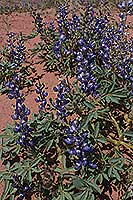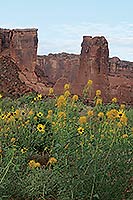As spring rolls into the Canyon Country, a procession of wildflowers kicks off the season. Some of the early flowers such as Parry’s biscuitroot and Newberry’s twinpod, with its inflated seedpods, initiate this parade. Though these may be the first to flower, they are not the last.
As the temperatures rise in spring so do the number of insects that provide pollination services for the flowers. Flies, bees, beetles, moths, butterflies, and even ants act as agents transferring pollen between plants. Hummingbirds may even be observed sticking their heads into a penstemon and getting dusted on the forehead with pollen which they then carry to another plant.
Plant and pollinator are tied together in this annual ritual, one that has been going on for thousands of years. Here are a few wildflowers to be on the lookout for when hiking in the desert.
Members of the Pea family are well represented with lupines and locoweeds blooming in the spring. Silvery lupine has numerous flowers born on tall stalks while dwarf lupine is a low-growing species found growing in sandy sites and bearing blue pea-shaped flowers with white banners. If any bumblebee pollinators are about, watch as the bees land on the lower petals which causes them to split and a spike-like appendage, called the keel, to rise up. The keel contains the flower’s anthers and stigma which the bees pollinate and collect pollen for food.
Desert paintbrush is a vivid member of the desert plant community. Several species exist in the area and most are pollinated by hummingbirds while reaching down into the flower’s throat to extract the sweet nectar rewards at the base. 
Members of the Yucca family are hard to miss with their stiff, sharp leaves and tall flower stalks that bear creamy-white flowers. Native Americans harvested the leaves, soaked them in water to soften the fibers, then teased apart the long fibers to create thread. These threads were then woven together to form cordage to create snares, sandals, or rope.
The coolest aspect of the yucca is the moth that pollinates it. The pronuba or yucca moth is about ½” in length and lands on the outer flower petals before crawling between the petals to the flower’s insides. There the female moth collects pollen in her mouth parts before traveling to another plant, placing the pollen onto that flower’s female stigma, and depositing her eggs into the base of the flower’s ovary. As the seedpod matures, her larvae consume some of the developing seeds before dropping to the ground and pupating underground.
Several species of milkweed also start to bloom in April. Broadleaf, spider, pallid, and showy milkweed are different looking species that bear milky latex which is toxic to most chewing insects except monarch caterpillars and a few other bugs. Adult butterflies are attracted to these uniquely-shaped flowers to sip nectar and transfer saddlebag-like sacs of pollen which attach to their legs to other plants.
Though the slickrock canyons and sandstone features are spectacular to look at, don’t forget to investigate the wonders of desert wildflowers up close. You may be surprised at what you find.


